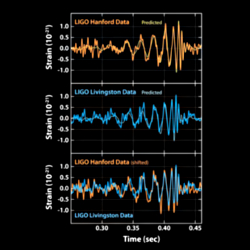 HEAPOW: 100 Milliseconds that Shook the World (2016 Feb 15)
HEAPOW: 100 Milliseconds that Shook the World (2016 Feb 15)
Chirp! That's the sound that colliding black holes make, as we know now thanks to LIGO, the Laser Interferometer Gravitational-Wave Observatory. According to Einstein's century-old General Theory of Relativity, the acceleration of any mass generates so-called "gravitational waves" which ripple through spacetime, causing space itself to stretch and contract with the wave with a predictable frequency and amplitude. So, if you have an extremely precise ruler, you can detect the passage of a gravitational wave by watching the oscillations of the ruler's length. The ruler needs to be extremely precise, though, since the oscillations produced by the acceleration of even the most massive objects are extremely tiny. Extreme events, like the incredible accelerations produced by two black holes as they spiral together, produce much stronger signals which can now be detected. LIGO is, in essence, an extremely precise ruler, capable of measuring infinitesimal changes in its length, such as would be produced by the gravitational waves from the merger of two massive black holes. When massive black holes merge (at least according to General Relativity, now confirmed by LIGO) they spiral together, moving faster and faster, until they are accelerated to a good fraction of the speed of light. This produces stronger and stronger gravity waves, with a characteristically-increasing frequency, causing space to vibrate faster and faster until the black holes merge. On September 14, 2015 at 5:51 a.m. Eastern Daylight Time, LIGO saw the clear pattern of such an event. The image above shows the oscillation in the lengths of the LIGO rulers (two sets of two mirrors, each pair of mirrors separated by four kilometers) at the two LIGO sites, one in Hanford, Washington and one 3000 kilometers away in Livingston, Louisiana. The length change recorded by both LIGO sites became larger and larger, and faster and faster, until suddenly the oscillations died down. This nearly exactly matches the pattern predicted by the General Theory for a pair of merging black holes. Analysis of the LIGO data showed that this event, dubbed GW150914, originated from the inspiral and merger of two black holes each having a mass of about 30 times the mass of the Sun, which occurred in a galaxy about 1.3 billion light-years distant. The ripples in spacetime produced by this event, moving at the speed of light, travelled for 1.3 billion years until detected by LIGO. Though this event lasted only about one hundred milliseconds, and produced a change in separation smaller than the size of a proton, its impact is enormous. This ground-breaking observation opens up an entirely new way to view (and hear) the Universe, and allows us to detect cataclysms and phenomena which heretofore passed undetected in the dark night.
LIGO: Gravitational Waves, As Einstein Predicted
LIGO: Gravitational Waves Detected 100 Years After Einstein's Prediction
http://asterisk.apod.com/viewtopic.php?p=254251#p254251
http://asterisk.apod.com/viewtopic.php?p=254271#p254271
http://asterisk.apod.com/viewtopic.php?t=35635
http://asterisk.apod.com/viewtopic.php?t=35638
| << Previous HEAPOW | High Energy Astrophysics Picture of the Week | Next HEAPOW >> |